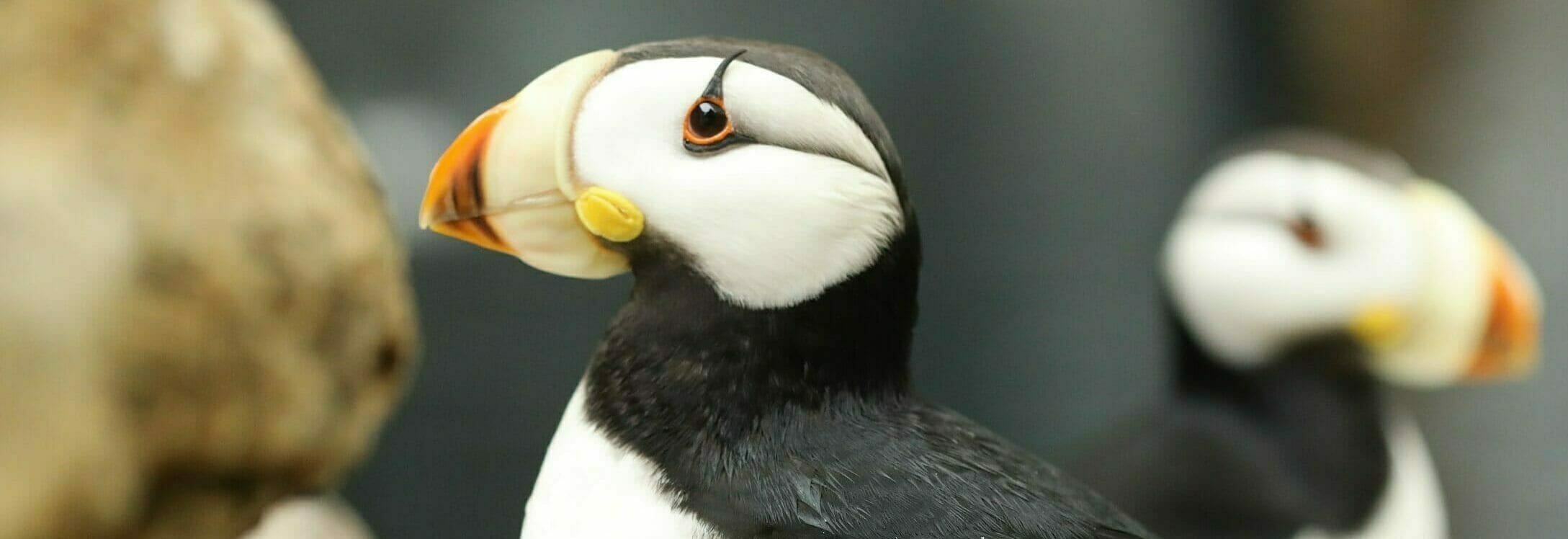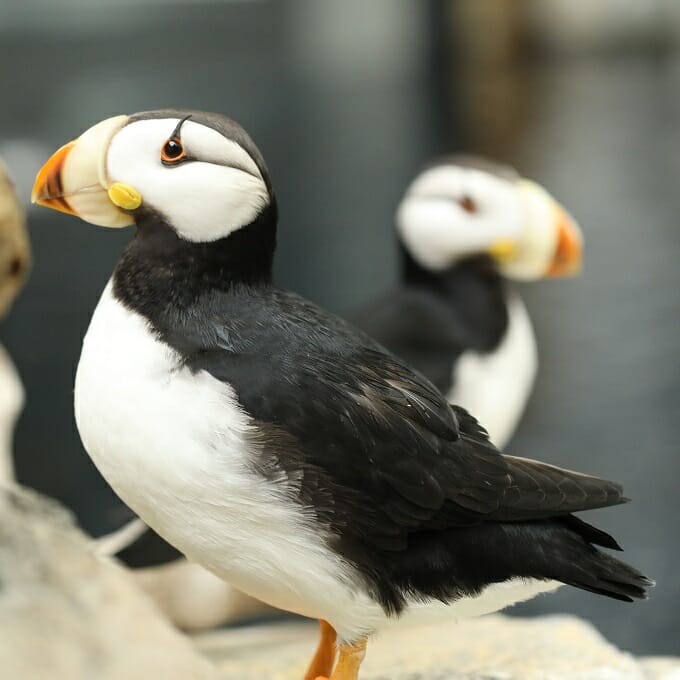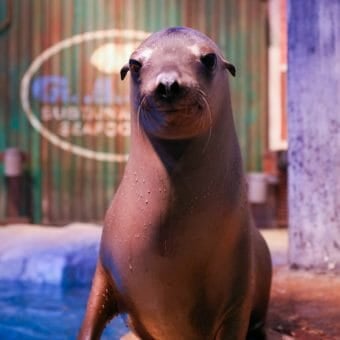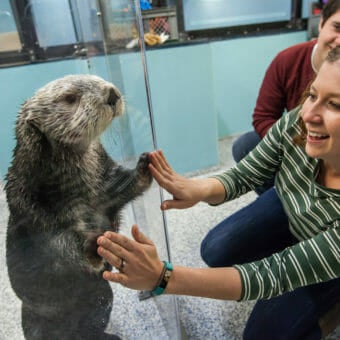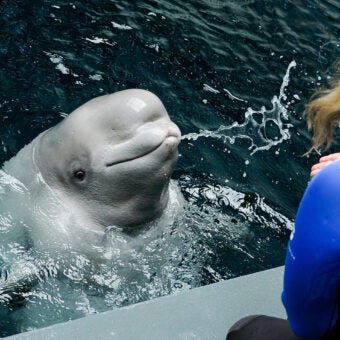-
Size
12 inches (30.5 cm) tall -
Diet
Fish, squid, crustaceans and polychaetes (marine worms) -
Range
Northern Pacific and Southern Arctic -
Habitat
Along sea coasts, rocky cliffs and offshore islands
Physical Characteristics
Size:
- Medium to large member of the auk, or alcid, family.
- Common height of 12 inches (30.5 cm).
- Wingspan range is 7-8 inches (18-20 cm).
Appearance:
- Coloration is black on the back, around the neck and on top of the head with white on the face, breast, belly and under the tail. Legs and feet are orange to red.
- Dark, hornlike projection from the top of the eye and thin, dark line from eye to nape.
- Very large, colorful bill during mating season. Yellow at the base and red at the tip.
- After the breeding season, undergoes annual molt, which takes place in fall to winter. The colorful outer part of the bill is shed, leaving behind the smaller, duller true bill. The face patch is grey, and the horn above each eye disappears.
- Males and females are similar in appearance. The males are larger.
- Juveniles appear similar to adults with a smaller, darker bill.
Animal Fact
Unlike penguins, horned puffins and other alcids can fly, although they mostly swim while at sea.
Diet / Feeding
- Diet consists of a wide variety of fishes, including juvenile herring, capelin, sand lances and sometimes salmon and cod, as well as squid, crustaceans and polychaetes (marine worms).
- Chick diets consist primarily of sand lances and capelin.
- Captures prey by surface diving. May dive up to 80 feet (24 m) in pursuit of prey.
- Forages over waters close to breeding colonies, unless iced over.
- May carry more than one fish at a time in its bill. The average catch is about 10 fish, but some may carry more than 60.
Range / Habitat
- Northern Pacific and Southern Arctic from the coast of Japan and Southwest Canada in the south, up to and including the Chukchi Sea in the north.
- Rarely seen as far south as California.
- A pelagic seabird. Spends much of the year offshore; returns to the coast in the summer to nest and raise chicks.
- During the breeding season, its found along sea coasts, rocky cliffs and offshore islands.
- During the non-breeding season, it ranges over adjacent waters usually only to the edge of the continental shelf.
Reproduction & Growth
- Breeds along the coast of British Columbia, some islands and peninsulas around Alaska, and along the Bering Sea coast of Russia on islands and coastal areas.
- Forms large breeding colonies on coastal cliffs or offshore islands, often mixed with other puffins and auks.
- Nests in crevices in the rocks or burrows in the soil.
- Breeds once yearly, from April to July.
- Forms monogamous pairs.
- Mating takes place mostly in the water. The most common time for mating is in the morning or evening.
- Indicates readiness by head flicking, which may be done on land or in water. Other courtship behaviors include bowing and placing bills side by side.
- Males may perform a swimming display in which they raise out of the water and extend their necks upwards.
- Mating pairs produce one oval-shaped egg per season, which is gray with purple dots. If lost, it is replaced in 10-21 days.
- Eggs are incubated by both parents and hatch after about 40-42 days.
- Parents continue to care for the chick for the first 6 days after hatching. After this, they will leave the chick in the nest and bring it food. Chicks fledge at about 35 days.
- Both males and females reach reproductive maturity between 3-5 years of age.
Conservation Status
- “Least Concern” on the IUCN Red List.
- The population is suspected to be in decline due to predation by invasive species and habitat destruction.
- Threats:
- A major cause of mortality for this species is bycatch in gillnets.
- Bycatch was most significant in the 1950s-1960s, when tens of thousands of puffins were killed by the salmon and squid fisheries.
- Since that time, bycatch has been more carefully monitored to prevent further decline.
- Some birds have been found to carry toxic trace metals in the liver, including mercury and cadmium, from the fish that puffins prey upon.
- A major cause of mortality for this species is bycatch in gillnets.
Additional Information
- Colonial species with aggregations of various sizes.
Taxonomy:
- There are three species of puffin:
- Horned puffin (Fratercula corniculata)
- Tufted puffin (Fratercula cirrhata)
- Atlantic puffin (Fratercula arctica)
- The genus name, Fratercula, means “little brother” in Latin, a reference the black and white coloration of these birds, which resembles the robes of a monk.
- Puffins belong to a group of seabirds known as auks, or alcids.
- Auks are medium-sized seabirds with long bodies, short tails, small wings and short legs set far back on the body.
- Auks occur mostly in the Northern Hemisphere. While often compared to penguins, which occur in the Southern Hemisphere, the similarities auks share with penguins are due to convergent evolution, whereby organisms not closely related develop similar traits as a result of having to adapt to similar environments.
- Unlike penguins, puffins and other alcids can fly, although they mostly swim while at sea.
Swimming/Flight Behavior:
- Puffins and other alcids are well adapted for life on the ocean. Their small wings and legs set far back on the body make these birds excellent swimmers and divers. However, these same traits make alcids clumsy on land and make taking flight more challenging.
- Puffins swim by using wings to “fly” underwater.
- Must beat wings rapidly in order to take off and fly.
Communication:
- Not a vocal bird, but may become so when threatened.
- Typically quiet while at sea, but louder in breeding colonies.
- Vocalizations are low-pitched groans and growls. Sharper squawks or caws may be used defensively. A softer, repetitive popping or clicking noise may be heard during head flicking.
- Visual displays are used during courtship and for defending nests.
Predation:
- Preyed on primarily by introduced species. Predators include the arctic fox, red fox and Norwegian rats.
- Protected by isolated and hard-to-reach nesting sites.
Economic importance:
- Historically hunted for food and clothing, although this is now discouraged or illegal in many areas.
- Those who do still hunt these birds attempt to capture only non-breeding individuals.
- Puffin colonies have now become tourist attractions in parts of their range. Since human disturbances may cause puffins to leave their nesting sites, visitors are often prohibited from landing at colonies and must watch the birds from the ocean.
